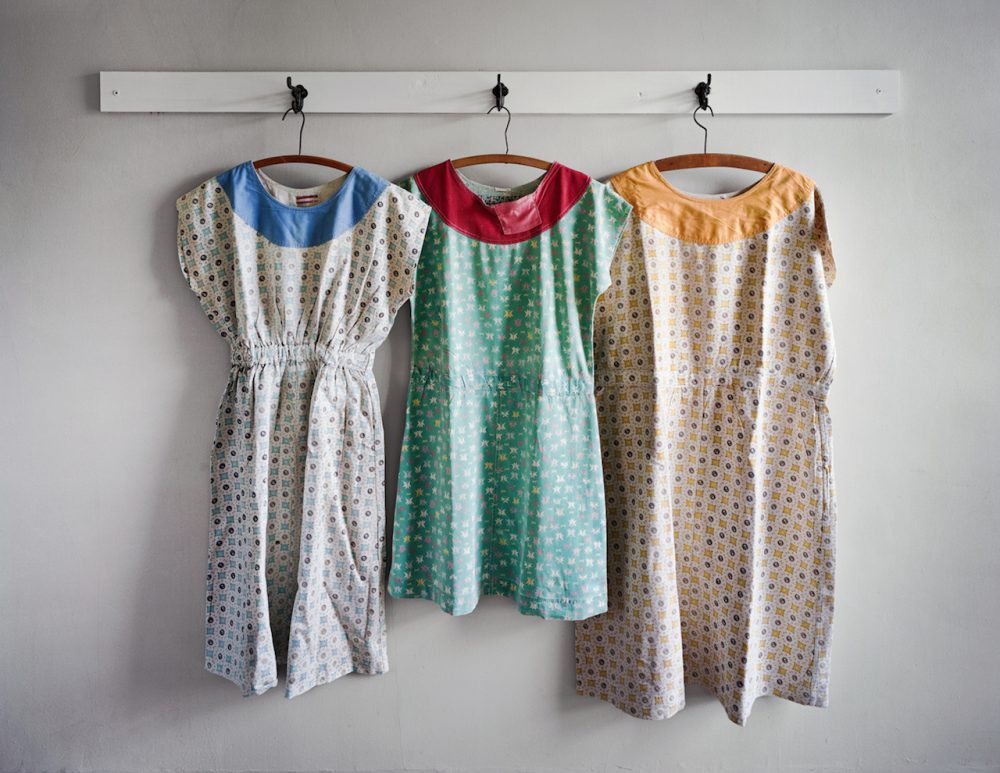Editor’s Letter: Mutual Support
Pelican Bomb’s Executive Director Cameron Shaw introduces our new thematic series exploring wellness, care, and healing.

Christopher Payne, Patient Dresses Made at Clarinda State Hospital, Clarinda, Iowa, 2008. Digital chromogenic print. Courtesy the artist and Benrubi Gallery, New York.
I started thinking about the ideas that would form the basis of Pelican Bomb’s “Mutual Support” exhibition in what feels like a different time. It was at least the illusion of a different time. We had a president in the White House that I, for one, was proud of, who didn’t brag about sexually assaulting women, tearing apart families, or destroying our environment, and who promoted education, hard work, and civic responsibility as virtues. Those feelings of pride and progress are now, under the current administration, impossible to conjure. The conversations for “Mutual Support” began casually over beers in 2014 with photographer and educator Saul Robbins. Together we thought about his practice of photographing therapists’ offices in New York, slowly adapting it into the project it is today, one that examines and celebrates the spaces for healing that serve our New Orleans communities and the urgent need to promote them, support them, and offer more like them. The artists and projects ultimately included in “Mutual Support” represent radically different approaches to service but are all united by their interest in mental health, wellness, care, and collectivity. There is something else they have in common: prompting the question of when and how we know that a change has occurred—in individuals, families, communities, and systems.
I recently had a conversation with a venerable local critic and thinker about the historical role of art as a shamanic practice, where art’s function is centered on its ability to bring about change (think rain ceremonies, initiation rituals, and other spiritual communions), and how and when it began to stray from this purpose. I like thinking about the artists featured in this exhibition— Robbins, Tatyana Fazlalizadeh, Rachel Wallis, Evan Falbaum, and the residents of Shreveport, Louisiana, working under the direction of Nick Cave—within that tradition and their dedication and commitment as a form of modern-day alchemy.
Last year, I had the privilege of traveling to Shreveport to participate in Cave’s residency with the Shreveport Regional Arts Council, and I count it as one of the most significant art experiences of my life. In the culminating performance, which took place in downtown Shreveport’s historic Municipal Auditorium, there is a moment when ten black men of differing ages transition from humble street clothes into otherworldly beings on stage with the help of Cave’s glorious soundsuits. As a full choir sang, led by soloist Brenda Wimberly, I wept, as did everyone I could see in the audience. It was a moment that underscored in the most visual and visceral ways the power of transformation—the power of seeing oneself differently and knowing one is being seen differently in the eyes of others.
For the next month, we’re using the Art Review to further explore these moments of change, discovery, and healing. We’ll be publishing commissioned essays on and interviews with artists including Lygia Clark, Ann Hamilton, Yumi Sakugawa, and Corinne May Botz. We are also considering how artists can work and collaborate with each other to imagine new forms of collective action for support and visibility, whether a group of painters creating portraits of each other here in New Orleans or activists in Berlin attempting to construct an archive of queer art. And we’ll share personal essays exploring sickness, grief, and the need for an intersectional approach to medical care. My hope is that these stories, interviews, exhibition reviews, and digital artist projects will offer expansive and unexpected ways to think about wellness, self-affirmation, and generosity in our own lives and with others.



